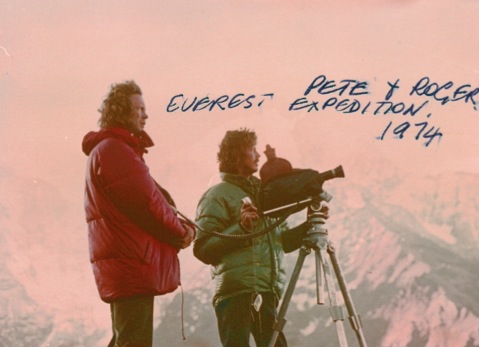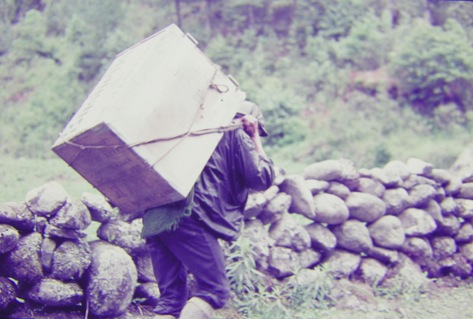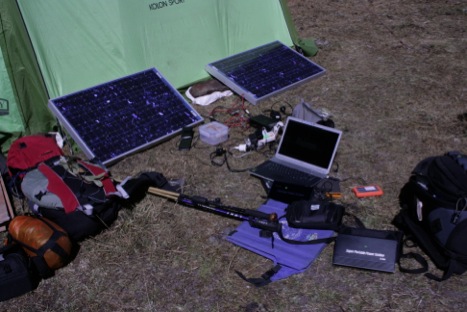Expedition video gear
17/02/14 15:16
The biggest problems with expedition videography are power, temperature and dust. When I first came to the Himalayas in 1974 on a film shoot with Ed Hillary we had an Éclair film camera and a tea chest of batteries. We used hot water bottles to keep the camera and batteries warm.

Pete and Roger Donaldson filming with Éclair camera and hot water bottle 1974

A crate of 12 V lantern batteries in 1974
Modern video equipment uses much less power however digital storage is a problem for a long expedition so two laptop computers must be taken (one as spare). We took a Sony Vaio laptop which could read the special SXS cards directly from the Sony EX1 camera. (Since then cheap card holders using SD cards such as those from MXM https://mxmexpress.com have solved the cost issue) There were two potential problems caused by that approach. Firstly the Vaio consumed around 100 watts and secondly its hard drive like most modern hard drives had a small head gap and was not guaranteed to work over ten thousand feet. Since we were going to twice that I talked to Everest veterans and they suggested an older hard disk. So I installed an old 80 Gb drive into an old LG laptop as an emergency spare. Fortunately I was able to cover shooting above 16000 feet with the cards I had and then download in the valleys. Download disks were ruggedised LaCie units. For power we had a porter carry two 60 watt glass solar cells and an inverter which we set up whenever we stopped. These were used to charge two large Polarmate 200 watt hour lithium ion cells and Sony batteries from which we ran the video camera and computer. The Polarmate cells could provide voltage from 3V to 26V and came with a wide range of connectors. I also carried a small flexible 12 V/6 watt solar cell on my pack to charge small AA cells and still camera batteries. All equipment worked faultlessly apart from a few minor wiring glitches at the start.

Solar cells plus inverter, laptop and Polarmate lithium ion cell.
Low temperature causes two problems namely poor battery life and condensation. We kept batteries in our down jackets or sleeping bags when not in use. A sealable plastic sack kept moisture and dust from the camera gear. I also carried two catalytic pocket warmers which run on lighter fuel although this creates problems when flying.

Pete and Roger Donaldson filming with Éclair camera and hot water bottle 1974

A crate of 12 V lantern batteries in 1974
Modern video equipment uses much less power however digital storage is a problem for a long expedition so two laptop computers must be taken (one as spare). We took a Sony Vaio laptop which could read the special SXS cards directly from the Sony EX1 camera. (Since then cheap card holders using SD cards such as those from MXM https://mxmexpress.com have solved the cost issue) There were two potential problems caused by that approach. Firstly the Vaio consumed around 100 watts and secondly its hard drive like most modern hard drives had a small head gap and was not guaranteed to work over ten thousand feet. Since we were going to twice that I talked to Everest veterans and they suggested an older hard disk. So I installed an old 80 Gb drive into an old LG laptop as an emergency spare. Fortunately I was able to cover shooting above 16000 feet with the cards I had and then download in the valleys. Download disks were ruggedised LaCie units. For power we had a porter carry two 60 watt glass solar cells and an inverter which we set up whenever we stopped. These were used to charge two large Polarmate 200 watt hour lithium ion cells and Sony batteries from which we ran the video camera and computer. The Polarmate cells could provide voltage from 3V to 26V and came with a wide range of connectors. I also carried a small flexible 12 V/6 watt solar cell on my pack to charge small AA cells and still camera batteries. All equipment worked faultlessly apart from a few minor wiring glitches at the start.

Solar cells plus inverter, laptop and Polarmate lithium ion cell.
Low temperature causes two problems namely poor battery life and condensation. We kept batteries in our down jackets or sleeping bags when not in use. A sealable plastic sack kept moisture and dust from the camera gear. I also carried two catalytic pocket warmers which run on lighter fuel although this creates problems when flying.


